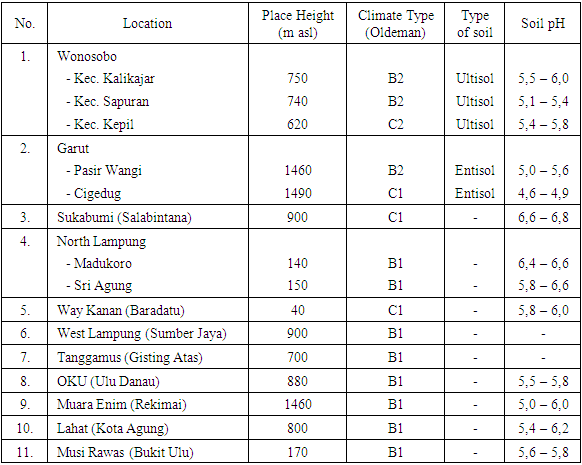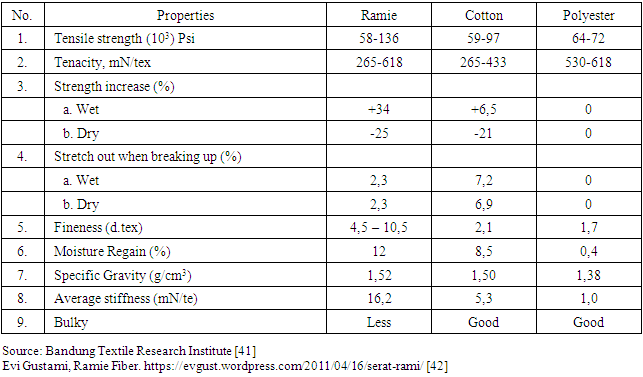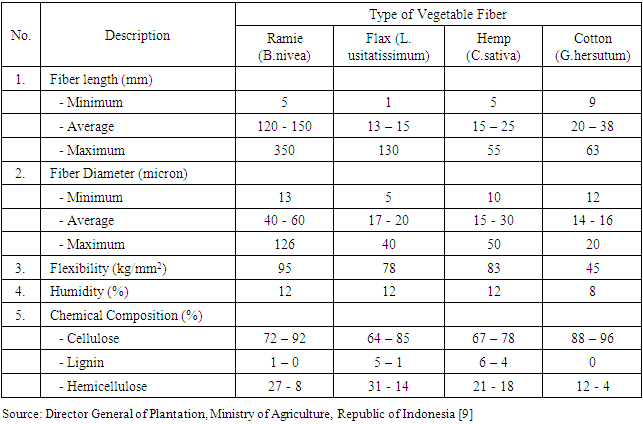-
Paper Information
- Paper Submission
-
Journal Information
- About This Journal
- Editorial Board
- Current Issue
- Archive
- Author Guidelines
- Contact Us
International Journal of Composite Materials
p-ISSN: 2166-479X e-ISSN: 2166-4919
2021; 11(3): 43-53
doi:10.5923/j.cmaterials.20211103.01
Received: Aug. 30, 2021; Accepted: Sep. 30, 2021; Published: Oct. 30, 2021

Prospect of Ramie Fiber Development in Indonesia and Manufacturing of Ramie Fiber Textile-based Composites for Industrial Needs, an Overview
Sudirman Habibie1, Nandang Suhendra1, Budiman Adi Setiawan2, Muhammad Hamzah1, Nuning Aisah1, Diah Ayu Fitriani1, Riesma Tasomara1, Mahendra Anggaravidya1
1Agency for the Assessment and Application of Technology, Republic of Indonesia
2Universitas Pembangunan Nasional “Veteran” Jakarta
Correspondence to: Sudirman Habibie, Agency for the Assessment and Application of Technology, Republic of Indonesia.
| Email: |  |
Copyright © 2021 The Author(s). Published by Scientific & Academic Publishing.
This work is licensed under the Creative Commons Attribution International License (CC BY).
http://creativecommons.org/licenses/by/4.0/

The needs of the textile industry for cotton natural fibers are very large and almost 100% are obtained from imports. To reduce dependence on cotton fiber, it is necessary to develop other natural fiber material sources. Ramie plant (Boehmeria nivea GAUD) has long been developed in Indonesia, but the results have not been encouraging. Ramie fiber with superior properties such as tensile strength and higher moisture regain than cotton, can be used as an alternative to replace cotton. The purpose of this paper is to illustrate that ramie fiber has the prospect of being developed in Indonesia as a substitute for cotton, given the land suitability and proven agricultural methods. In addition, the author provides an overview of one of the uses of ramie fiber is the manufacture of ramie textile-based composites which are used for various industries. The author did not deepen the study of composite technology, but slightly raised the VARI technology as well as several industrial users such as construction and aerospace industries.
Keywords: Natural fiber, Ramie fiber, Textiles, Composites, VARI techniques
Cite this paper: Sudirman Habibie, Nandang Suhendra, Budiman Adi Setiawan, Muhammad Hamzah, Nuning Aisah, Diah Ayu Fitriani, Riesma Tasomara, Mahendra Anggaravidya, Prospect of Ramie Fiber Development in Indonesia and Manufacturing of Ramie Fiber Textile-based Composites for Industrial Needs, an Overview, International Journal of Composite Materials, Vol. 11 No. 3, 2021, pp. 43-53. doi: 10.5923/j.cmaterials.20211103.01.
Article Outline
1. Introduction
- Indonesia is the second largest importer of cotton fiber in the world [1]. In general, the demand for raw materials for the textile and textile products (TPT) industry increased from 365 thousand tons to 500 thousand tons [2]. From 2010 to 2013, cotton imports increased by 99% [4]. According to Ade Sudrajat, Chairman of the Indonesian Textile Association, imports of cotton in Indonesia reached 99% and only 1% of which was met from domestic cotton [1].Increasing local cotton production is difficult to achieve because cotton plants are very susceptible to pests or diseases and require a specific biophysical environment, making it difficult to reduce dependence on imported cotton continuously [3]. These conditions open up opportunities to develop ramie (Boehmeria nivea L. Gaud) as a substitute for cotton as the main raw material for textiles.The ramie plant is thought to have originated from central and western China, so this plant has grown well in the country. Ramie plant in Latin is known by the name (Boehmeria nivea L. Gaud) which is a fiber-producing plant. The ramie plant produces fibers from the bark which are used for textile raw materials. Apart from being known as a producer of fiber, the leaves of the ramie plant can be used as fertilizer and animal feed ingredients and have several nutritious ingredients [4]. From the research results, the quality of ramie fiber in Indonesia is able to compete with ramie fibers from China, Brazil, the Philippines, Taiwan, Korea, Komboja, Thailand and Vietnam. Thus the development of this plant has a very bright prospect, because until now ramie farming in Indonesia has a great potential to drive the people's economy through the rural economy [5]. Thus, the use of ramie fiber as a composite panel reinforcement is one of the right solutions to increase the technological and economic value of ramie fiber.Research from the World Ramie Fiber Institute and Swizerland Ernest H. Fisher Sons Ltd in the decade 1985-2000 states that the global demand for ramie fiber is estimated at 400,000-500,000 tons per year. However, so far the supply from China, Brazil and the Philippines has only reached 120,000-150,000 tonnes per year [6]. In Indonesia, the national production of ramie fiber was 11 tons in 2007, only fulfilling 0.006% of the national fiber consumption which reached 500 tons/day [7]. Based on the demand for ramie in the world and the domestic market, the opportunity to develop ramie to supply fiber as a textile raw material is still wide open.In Indonesia, there are many ramie producing areas such as Wonosobo, Lahat, Pagar Alam, Muara Enim, North Lampung, West Lampung, Tanggamus, Toba Samosir and other areas. The planting and production area of ramie in 2012 was 1,353 ha and 997 tonnes, in 2013 it was 1,166 ha and 678 tonnes and in 2014 it was 1,171 ha and 683 tonnes [4] or there was a decrease in factory area from 2012-2014 of 15.54 % and ramie production in 2012-2014 was 15.54% and ramie production in 2012-2014 was 45.97% [8].In 2000, ramie fiber proposed by a large textile company in Indonesia to Japan was tested. The parameters tested were the level of fineness and strength. As a result, the level of fineness of Indonesian ramie reached 3.8. The international standard for the free market is below 4. As for the strength scale, Indonesian ramie reaches 6.7, while the international standard is above 6. With these specifications, Indonesian ramie is basically guaranteed its quality and will be accepted by the global market. The quality of ramie fiber is highly dependent on the quality of the fiber raw material, both from internal and external aspects. Quality cannot be seen or touched and is related to fineness, fiber count, strength and pectin content. External quality is primarily concerned with what you can see and touch. Different varieties of ramie will produce different fiber qualities. In general, the quality of ramie fiber can still be improved through improvements in terms of agronomy as well as improvement and development of post-harvest processing and handling processes [6].According to Dirjenbun (2012) [9], ramie fiber has superior quality and quantity compared to cotton fiber, this can be seen from several test parameters such as 120-150 mm length of ramie fiber, 40-30µ fiber diameter, 95 g / denier fiber strength. and ramie has a 12% higher absorption rate than cotton. However, the fiber fineness value is lower.Ramie fiber which has a high enough strength is more widely used as technical textiles or functional textiles, such as geotextiles, military textiles, medical textiles, and others. Another use is the manufacture of ramie textile based composites.This paper generally discusses ramie agricultural technology, ramie fiber processing, and the use of ramie fiber for ramie fiber textile-based composites and discusses a few industries that can take advantage of composite products.
2. Potential Development of Ramie in Indonesia
- Ramie plant has been known since the Japanese era (1942). Government and public attention to these potential plants has experienced ups and downs. For example, the Industrial Crops Research Institute (LPTI) began conducting research in 1955, then since 1960 the sequel has not been heard from again. In 1975 the Government established a special ramie fiber spinning mill in North Sumatra with a plant area of ± 600 Ha, but in 1968, PPN fiber together with the Japan Ramie and Ramie Spinner Association conducted a survey of ramie plants, but these efforts were not heard from again. It was only at the end of Pelita III that ramie fiber fever reappeared, following the development of the decorticator and degumming processing machines [10].Ramie (Boehmeria nivea (L.) Gaud.) Is an annual plant that has many benefits, see Figure 1. This plant is famous for its fiber from its bark which is used as raw material in the textile industry [11]. used as raw material for pulp & paper [12], land conservation, compost material [13], the roots are used as traditional medicine [14] and the leaves are used as material for animal feed [15], as well as various other industrial products.
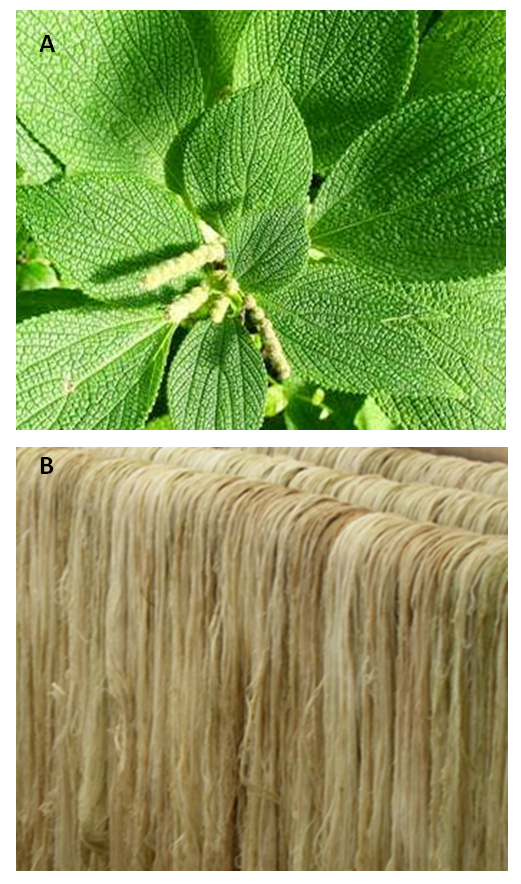 | Figure 1. Rami Plant (A) and Decortified Rami Fiber (B) |
2.1. Cropping Pattern
- Ramie cultivation can be done in monoculture and intercropping with coconut plants in plantations. In addition to planting on flat land, it can also be on sloping land or hilly land. While the soil is processed 1-2 times using a hoe, plow or tractor. Then made beds with a width of 3 meters, the length is adjusted to the circumstances of the place and the distance between the beds is 50-75 cm. If planting is done on sloping land, it is best if the beds are drawn along a dividing line to prevent erosion. In its cultivation, ramie can be planted with seeds, stem cuttings and rhizome root pieces. However, a plant material that is considered quite good and practical is rhizome slices. This material should be taken from high yielding varieties and is more than 2 years old [24].The next process, cut the rhizomes with a length of 15-20 cm each. Then the cuttings are planted in a damp place until new shoots appear and usually within a week new shoots will appear. For each hectare it takes 21-22 thousand sets of rhizomes [24]. Meanwhile, planting is carried out in the planting hole that has previously been given 0.5 kg of manure/hole, the spacing is 50-75 cm, and 2-3 cuttings can be filled in each hole. Meanwhile, a good planting time is at the beginning of the rainy season, or in other months where rainfall is still possible to grow.
2.2. Maintenance
- The main maintenance of plants is weeding, watering, improving drainage and fertilizing. Weeding must be adapted to the growing conditions of weeds and land. If watering includes watering in the dry season and improving drainage in the rainy season. Meanwhile, ramie is a type of plant that is sensitive to waterlogged soil. That is why, if there is standing water for more than 24 hours, it will cause the ramie plant to wilt and even possibly die [24].In an effort to accelerate growth and increase productivity, ramie plants need to be given artificial fertilizers, in addition to the manure given before planting. Artificial fertilizers are given when the plants are 2-3 weeks old in the form of a mixture of Urea, TSP and KCL. In general, the dosage of fertilization depends on soil fertility, but can use the TSP standard of 25-50 kg / ha, Urea 100-150 kg / ha and KCl as much as 50-100 kg/ha. Then the artificial fertilizer mixture is put into the fertilizer hole that has been perforated with a sharp stick at a distance of 10 cm from the base of the ramie plant [24,25].
2.3. Growing Conditions
- Ramie (Boehmeria nivea L. Gaud) is a perennial herbaceous plant that produces fiber from bark (bast fiber) which is located in the fine tissue of the bark [26] and is used for textile materials [27]. Ramie is a versatile plant, its leaves are compostable, highly nutritious animal feed and its stems are good for fuel. Ramie plant height can reach more than 2 m with the best harvest period of about 55 days in the lowlands and up to ± 3 months in the highlands / mountains [28]. The first pruning is carried out 2 months after planting to stimulate the growth of more new shoots [29]. According to Soeroto (1956) [30] ramie plants will grow and produce high in Indonesia and are planted in the medium to high plains (500-1500 m asl), this plant can be cultivated from the lowlands to the highlands (10-1500 m asl) [31]. The results of research by Habibie et al, 1989 [25] show that the highest fiber productivity is in the highlands (> 700 m asl) ranging from 2.5 to 3.0 tonnes/ha/year, moderate plains (400-700 m asl) range between 2.0-2.5 tons/ha/year, while the lowlands (<400 m asl) 1.5-2.0 tons/ha/year.The characteristics of its growth and development are very characteristic. Plants grown from rhizomes are harvested at the age of three months and shoots grown from the rhizomes of the first generation plants, namely ratoon {second generation plants}, can be harvested again within two months. The third generation of plants is a generation that is stable in terms of quantity and quality of fiber yield.
2.4. Land Suitability
- Ramie requires fertile, loose soil with loamy, sandy, textured loam and dusty loam loam. The desired soil acidity (pH) ranges from 5.4 to 6.5. Rainfall suitable for growing ramie is 1,500-2,500 mm/year with rainy days evenly distributed throughout the year [32]. Based on the growing needs, the land suitable for the development of ramie is very wide, especially on the islands of Sumatra and Java. The biophysical conditions of ramie development areas in Sumatra and Java can be seen in Table 1.
|
 | Figure 2. Location of Ramie Plantation in Indonesia [9] |
2.5. Harvest
- In well-drained plantations, ramie plants can be harvested at 3-4 months of age. However, the Florida variety generally harvests around 60 days, and the Formosa variety 45 days. What is certain is that the signs of the plant are ready to harvest, namely stopping growth, brown lower stems, fragile stems, the fibers have reached the shoots and new shoots appear at the base of the stem. If the plants are showing signs of harvesting, harvesting should be done immediately [33]. If left for more than 2 weeks, the quality of the ramie fiber produced is not good, and new shoots are not immediately given the opportunity to grow better. Harvesting is done by cutting the stems near the ground.We recommend that you do not take the fiber for the first time, but bury it to be used as fertilizer. The reason is, the quality of the fiber is still considered poor. Meanwhile, the next harvest can be done every 60-80 days. So that the first year you can harvest ramie 3-4 times and in the following years you can harvest 6 times a year.The production of fresh ramie sticks per harvest can reach around 10 tonnes per hectare. The production lifespan of ramie ranges from 5–10 years [33], depending on the variety, environmental conditions and also the maintenance. If the production has decreased, it is necessary to rejuvenate the old plants which have had their rhizomes and roots removed. Then do land cultivation and new planting as in the first planting.
2.6. Ramie Plant Productivity
- According to the Bogor Industrial Research Institute (LPTI), the average yield of one hectare is around 36 tons of wet stems with a yield of between 3.5-4%, so it is estimated that it is around 1.3 tons/ha of dry fiber. Ramie plants per hectare per year are 125 tons consisting of 40% green leaves (50 tons) and 60% wet stems (75 tons). From wet stems 3.5% (2,625 tonnes) of dry fiber will be produced and 16% (12 tonnes) of waste will be generated [36]. The productivity of ramie fiber depends on the height and diameter of the stem, the thickness of the bark and the yield of the fiber (fiber content per stem). Ramie stems are harvested for fiber production once every 2 months so that 1 year (in tropical areas) can be done 5-6 times. The content of crude fiber (Chinese grass) is generally around 2-4% fresh stalks, oil-removing fiber about 1-3% and ready-to-spin fiber (ramie top) around 1-2% [31,37].The collection of ramie plants in the Tobacco and Fiber Research Institute (Balittas) Malang currently amounts to 101 clones [38]. Purwati (2010) [39] reported that in Balittas there were 21 clones of ramie introduced from a number of fiber-producing countries in the world. The results of the ramie clone test showed that several superior clones for the lowlands were Pujon 10 (Ramindo 1), superior clones for the plains of Florida, Lembang A, Bandung A and superior clones for the highlands namely Seikiseishin. Superior clones of ramie plants are: clones of Lembang A, Indochina, Ramindo 1, Padang 3 and Bandung A. This plant is able to live in the lowlands of 265-350 m asl in Limau Manis, Padang.According to Desti (2012) [40], the morphological characterization of Lembang A, Indochina, Ramindo 1, Padang 3 and Bandung A can be distinguished from the color of the petiolus, the color of the shoots and the color of the female flowers. Ramindo 1 clones are marked with petiolus color and reddish green shoot color with pink female flowers while molecular characterization using OPC 02 and OPN 14 primers shows pure clones only clones of lembang A. The impure clones are suspected because the clones have mixed with other clones and hybrid results between clones.
2.7. Properties of Ramie Fiber
- Ramie fibers are obtained from the bark (ribbon). In the stem cells the fibers are tied to each other with sap (adhesive) to form a continuous connection until they can reach 90-180 cm in length. The existence of this adhesive in the processing process needs to be carried out by a degumming process, namely the separation of the fibers from one another and because the adhesive does not dissolve in water, the process is carried out chemically. The following properties of ramie fiber are white, easy to dye, strong and not easy to change, not easy to rot, when compared to other vegetable fibers, ramie fiber has a tensile strength greater than linen, silk and 7 times the strength of cotton fibers. The moisture absorption is 12%, which is higher than cotton which only absorbs 8%. Chemical analysis shows that cellulose is the main component of ramie fiber. The chemical composition of ramie fibers can be seen in table 2 [41].
|
|
|
3. Manufacture of Natural Fiber Textile-based Composites
- Composite is a material consisting of a mixture or combination of two or more materials either micro or macro, the properties of these materials are different in shape and chemical composition from the original substance [46]. Another opinion says that a composite is a solid-phase material combination consisting of two or more materials on a macroscopic scale which has a better quality than the forming material [47].Composite material is a non-metallic material that is currently being used more and more considering that the material needs in addition to prioritizing mechanical properties are also needed other better properties such as light weight, corrosion resistance, and environmental friendliness.Composite textiles with reinforcing materials consist of various reinforcing materials in the form of textile preforms which can be formed by nonwoven, woven or knitted materials. In order to choose the optimal technology for preparing a textile preform, it is necessary to consider the strengths and weaknesses of each. Different methods are used to obtain a composite structure: embedding a reinforcing material (textile webbing) into the matrix, which can be a macromolecular substance or colloid solution or suspension with coagulation properties; consolidation of the base material by heating (curing) the layers, resulting in lamination.Woven fabrics are usually constructed with reinforcing bars, strands, or threads interlocking themselves with an up/down placement during the weaving process. The more common styles of fabric are plain, keeper (twill) and satin, as shown in Figure 3. The plain weave is the most commonly used with a woven construction between the longitudinal (warp) and the transverse (weft) directions alternating from one another [48].
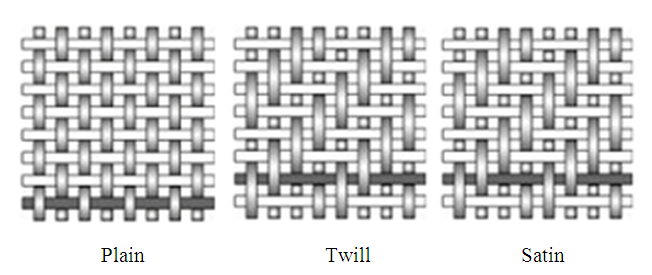 | Figure 3. Some of the commonly used weave styles as reinforcement in making composites [48] |
3.1. Natural Fiber Composites
- Natural fibers are fibers that come from nature such as palm fiber, pineapple fiber, coconut fiber, ramie, kenaf and others. According to Chandrabakty (2011) [49] there are several reasons for using natural fibers as composite reinforcement as follows:a. More environmentally friendly and biodegradable compared to synthetic fibersb. Natural fiber density is smallerc. Has a better weight-modulus ratio than E-glass fiberd. Natural fiber composites have a higher acoustic damping power than E-glass and carbon fiber compositese. Natural fibers are more economical than glass fibers and carbon fibers.In this modern world, the use of composite materials has begun to be developed in the manufacturing industry. The use of composite materials that are environmentally friendly and can be recycled again is the demand of today's technology. One of the composite materials expected in the industrial world is a composite material with fillers, both natural and man-made fibers. Basically a composite material is a combination of two or more different materials to form a microscopic unit, which is made of various combinations of properties or a combination of fibers and matrices. Currently, fiber-reinforced composite materials are the most widely used technical materials because of their specific strength and stiffness that are far above those of general engineering materials, so that their properties can be designed close to the requirements [50].In making composites, fiber and matrix are needed. The fiber serves as a reinforcing element that determines the mechanical properties of the composite as it continues the load transmitted by the matrix. The materials used as fibers are divided into two parts, namely natural and synthetic. Prior to BC natural fibers as reinforcement were used in composite materials. The walls of old buildings in Egypt that are more than 3000 years old are actually made of clay reinforced with straw [51]. However, in subsequent developments, natural fibers were abandoned because they had technical deficiencies and tougher materials were discovered, namely metals and their alloys. The weakness of the metal and its alloys is the high density so that the strength and stiffness are relatively low.The reuse of natural fibers is triggered by regulations on end of life requirements for automotive component products for European Union countries and parts of Asia. Even since 2006, EU countries have recycled 80% of automotive components, and this increase to 85% in 2015. In Asia, especially in Japan, around 88% of automotive components have been recycled in 2005 and increasing in 2015 to 95%. The development of natural fiber reinforced composite technology is in line with government policies to explore the potential of existing local geniuses. This will certainly be able to increase the empowerment of local renewable natural resources [52].In a preliminary study, Nugraha, et al. (2005) [53] conducted chemical treatment of natural fiber ramie (Boehmeria Nivea) which showed that the tensile strength of the fiber could be increased so that it would be able to become an alternative reinforcement medium for natural fiber reinforcing polymer composites. Marsyahyo, et al (2005) [54] compared the tensile strength of epoxy and polyester polymer composites with the strengthening of natural fibers from several tropical plants without being treated (green fibers) with the result that ramie fibers had the highest relative strength compared to natural fibers of pineapple leaves, banana stalks, kenaf, bamboo, coconut shell powder and agel (agave).The continuous and random treatment of kenaf fibers with 5% NaOH soaked at 19 ± 2°C for 48 hours caused the fiber surface to become rougher because the lignin layer and dirt on the surface of the fiber were lost. The rough fiber surface topography will result in better mechanical interlocking with matrices [55]. This method can also be used in the Ramie process to make a rough surface of the fiber, thereby producing adhesion strength to the material.
3.2. Composite Manufacturing Technology
- The manufacturing process or production process of these composites is very important in producing these composite materials. Many methods or methods are used to produce the desired composite material [56].Broadly speaking, the method of making composite materials consists of two ways, namely:1. The Open-Mold Process consists of: Hand Lay Up, Vacuum Bag, Pressure Bag, Spray-Up, Filament Winding.2. Closed mold Processes consist of: Press Mold Process, Injection Molding, Continuous Pultrusion.The Vacum Bag (VARI) technique is one of the methods of making composites with composites made in a mold which is closed by a bag that is tightly sealed and there is no leakage then the bag is vacuumed by a vacuum motor so that there is a difference in air pressure between the outside and in the bag which causes the bag will press the composite product to be made evenly and will also pull out the residue or excess resin in the manufacture of the composite [57].Therefore, the use of resin in the manufacture of composites with this technique is less than the hand lay up technique. In other words, in using resin, this technique is more efficient than using the hand lay up technique. In Figure 4, you can see an example of the vacuum assisted resin infusion (VARI) technique.
4. Utilization of Natural Fiber Composites for Industry
- The advantages of using composites are Light Weight, High Strength, Strength Related to Weight, Corrosion Resistance, High-Impact Strength, Design Flexibility, Part Consolidation, Dimensional Stability, Nonconductive, Nonmagnetic, Radar Transparent, Low Thermal Conductivity and Durable [58].
 | Figure 4. The Vacuum Bag Technique [57] |
5. Conclusions
- The dependence of the domestic textile industry on imported cotton fibers can be replaced with hemp fiber. Given the superior properties of ramie fiber in its strength and absorption, ramie fiber can be used as a garment textile material, besides that it is also very suitable for use as a technical textile material. Indonesia's geographical conditions are very supportive for the development of ramie plants given the sub-tropical climate. In agriculture, it is necessary to pay attention to the planting system, maintenance, fertilization and harvest time, as well as fiber processing.Ramie fiber textile-based composites will be a superior material to replace the functions of several metal and polymer materials in several applications such as: automotive, aerospace, construction, medical devices, and others.Technology options vary widely, such as molding system, prepeg, VARI, but users only need technology that suits their needs.The author suggests that further research should be carried out, especially on the manufacture of textiles using ramie fibers (long fibers), which emphasizes from the spinning process to weaving, as well as the finishing of ramie fabrics (textiles) to increase the adhesion between ramie fabrics (filler) and resin (matrix).
ACKNOWLEDGEMENTS
- The author would like to thank the Director of the Center for Material Technology for conducting a study on the prospects for developing natural ramie fibers as raw material for textiles and composites in Indonesia. The preparation of this paper is the result of discussions with colleagues about the potential for developing ramie plants in Indonesia, and its use for industry.
 Abstract
Abstract Reference
Reference Full-Text PDF
Full-Text PDF Full-text HTML
Full-text HTML